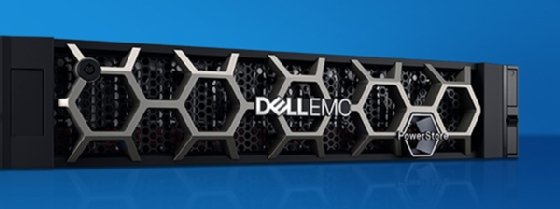
Nomad_Soul - Fotolia
Long-delayed Dell EMC PowerStore midrange array makes debut
All-NVMe PowerStore array supports any workloads across any environment. It is the vendor's first jointly engineered product since the Dell and EMC merger.
Enterprises can get a look at Dell EMC's next-generation midrange storage, more than a year later than the array's planned debut.
The Dell EMC PowerStore system that launched today marks the vendor's first internally developed storage product since Dell bought EMC in 2015. Integration of Dell EMC-owned VMware is a key element, with an onboard ESXi hypervisor and capability to run applications on certain array models.
The base PowerStore is a 2U two-node enclosure for active-active failover and high availability. The chassis takes 25 NVMe SSDs, with support for Intel Optane persistent memory chips. Three 25-drive SAS expansion shelves can be added per chassis. Support for NVMe-f architecture is on Dell EMC's roadmap.
The PowerStore midrange storage has been a strategic priority for several years. More than 1,000 engineers across Dell EMC storage and the wider Dell Technologies organization worked on the system, said Caitlin Gordon, senior vice president of Dell EMC storage marketing.
"Data has never been more diverse or more valuable, but customers have had to choose between prioritizing between service levels for performance and simplifying their operations. We know not every applications can be virtualized, and we engineered PowerStore so you can consolidate all workloads on a single platform," Gordon said.
What's next for Dell EMC midrange?
Dell EMC first scheduled the new midrange system to launch in 2019, but a series of delays pushed it back to now. The all-flash PowerStore adds to Dell EMC's overlapping midrange storage, although the vendor said the new system would help streamline the portfolio. Dell EMC is the market leader in storage, with midrange platforms that include the Unity flagship all-flash and hybrid arrays that EMC brought to market. Other midrange systems include the SC Series and PS Series. Dell acquired Compellent and EqualLogic arrays years ago and renamed both products. Compellent is now known as SC Series and still sold and supported by Dell. The EqualLogic arrays were renamed PS Series, which Dell maintains but no longer sells. Dell EMC executives said the other systems will be phased out slowly with PowerStore's arrival.

The PowerStoreOS operating system incorporates a Kubernetes framework to serve storage management from containers and includes a machine learning engine to automate rebalancing and other administrative tasks. Based on internal testing, Dell EMC claims PowerStore had seven times the performance and three times lower latency than Unity XT array.
The ground-up PowerStore design eventually will emerge as the dominant Dell EMC midrange storage, said Scott Sinclair, a storage analyst with Enterprise Strategy Group.
"This is a completely new architecture that's based on a container framework. It's designed to address a bunch of different workload needs on one array. That's not the type of hard work you put into a product do just to add another midrange storage array," Sinclair said.
A software capability called AppsOn allows data-intensive applications to access storage on PowerStore and use VMware vMotion to migrate it between core and cloud environments.
"The idea is you that can be within a VMware environment -- let's say VMware Cloud Foundation, or vSphere -- and have different ways to move applications to various targets. AppsOn is a novel approach that gives you more flexibility to deploy apps, based on your resource needs," Sinclair said
Beta customer tried to 'blow up' PowerStore
Dell EMC guarantees data reduction of 4-to-1 with always-on inline deduplication. Dell claims the inline data reduction does not degrade performance. Based on the ratio, a single Dell EMC PowerStore with three expansion enclosures is rated to provide 2.8 PB of usable storage per appliance. Effective capacity scales to 11.3 PB in a maximum eight-node cluster.
Five capacity models are available: PowerStore 1000 (384 TB), PowerStore 3000 (768 TB), PowerStore 5000 (1,152 TB), PowerStore 7000 (1,536 TB) and PowerStore 9000 (2,560 TB). PowerStore X models come with the VMware hypervisor and AppsOn, a software capability that allows data-intensive applications to access storage on the array across core and cloud environments. The Power T configuration does not include the latter features.
"I actually like the PowerStore X a lot more than I ever thought I would," said Alan Hunt, the director of network operations for Detroit-based law firm Dickinson Wright. Hunt is running a PowerStore X and PowerStore T in beta to simulate live production. He said PowerStore will help Dickinson Wright to incorporate new storage with existing SC Series and retire PS Series arrays.
"We did a lot of testing and migrating of live workloads with the AppsOn feature, and that was excellent. We're running simulate workloads and don't have anything in production [on PowerStore], but I want to jump on it immediately. I take systems and try to blow them up, and this was definitely the most stable beta test I've ever done," Hunt said.
Dell EMC initially said it would converge features of its multiple midrange arrays in 2019. The product launch was slated for Dell Tech World in Las Vegas in May, but that event was cancelled due to the coronavirus. Dell said it will have a virtual show later this year but has not specified dates.
Gordon said PowerStore systems started shipping in April.






